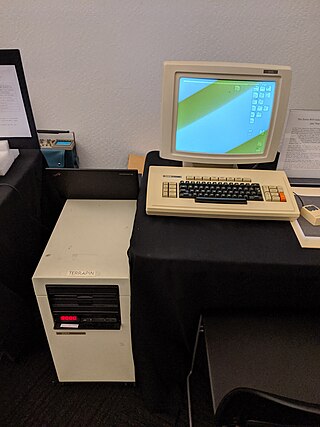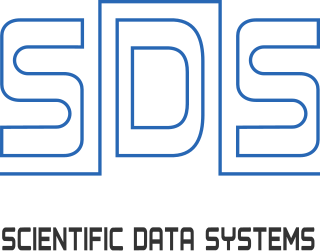
In computing, a printer is a peripheral machine which makes a persistent representation of graphics or text, usually on paper. While most output is human-readable, bar code printers are an example of an expanded use for printers. Different types of printers include 3D printers, inkjet printers, laser printers, and thermal printers.

A mainframe computer, informally called a mainframe or big iron, is a computer used primarily by large organizations for critical applications like bulk data processing for tasks such as censuses, industry and consumer statistics, enterprise resource planning, and large-scale transaction processing. A mainframe computer is large but not as large as a supercomputer and has more processing power than some other classes of computers, such as minicomputers, servers, workstations, and personal computers. Most large-scale computer-system architectures were established in the 1960s, but they continue to evolve. Mainframe computers are often used as servers.

In computing, time-sharing is the sharing of a computing resource among many tasks or users. It enables multi-tasking by a single user or enables multiple user sessions.

A word processor is an electronic device for text, composing, editing, formatting, and printing.

Xerox Holdings Corporation is an American corporation that sells print and digital document products and services in more than 160 countries. Xerox is headquartered in Norwalk, Connecticut, though it is incorporated in New York with its largest population of employees based around Rochester, New York, the area in which the company was founded. The company purchased Affiliated Computer Services for $6.4 billion in early 2010. As a large developed company, it is consistently placed in the list of Fortune 500 companies.

Laser printing is an electrostatic digital printing process. It produces high-quality text and graphics by repeatedly passing a laser beam back and forth over a negatively charged cylinder called a "drum" to define a differentially charged image. The drum then selectively collects electrically charged powdered ink (toner), and transfers the image to paper, which is then heated to permanently fuse the text, imagery, or both, to the paper. As with digital photocopiers, laser printers employ a xerographic printing process. Laser printing differs from traditional xerography as implemented in analog photocopiers in that in the latter, the image is formed by reflecting light off an existing document onto the exposed drum.

Computer operating systems (OSes) provide a set of functions needed and used by most application programs on a computer, and the links needed to control and synchronize computer hardware. On the first computers, with no operating system, every program needed the full hardware specification to run correctly and perform standard tasks, and its own drivers for peripheral devices like printers and punched paper card readers. The growing complexity of hardware and application programs eventually made operating systems a necessity for everyday use.

The Xerox Star workstation, officially named Xerox 8010 Information System, is the first commercial personal computer to incorporate technologies that have since become standard in personal computers, including a bitmapped display, a window-based graphical user interface, icons, folders, mouse (two-button), Ethernet networking, file servers, print servers, and e-mail.

Daisy wheel printing is an impact printing technology invented in 1970 by Andrew Gabor at Diablo Data Systems. It uses interchangeable pre-formed type elements, each with typically 96 glyphs, to generate high-quality output comparable to premium typewriters such as the IBM Selectric, but two to three times faster. Daisy wheel printing was used in electronic typewriters, word processors and computers from 1972. The daisy wheel is so named because of its resemblance to the daisy flower.

Typesetting is the composition of text by means of arranging physical type in mechanical systems or glyphs in digital systems representing characters. Stored types are retrieved and ordered according to a language's orthography for visual display. Typesetting requires one or more fonts. One significant effect of typesetting was that authorship of works could be spotted more easily, making it difficult for copiers who have not gained permission.

Wang Laboratories was a US computer company founded in 1951 by An Wang and G. Y. Chu. The company was successively headquartered in Cambridge, Massachusetts (1954–1963), Tewksbury, Massachusetts (1963–1976), and finally in Lowell, Massachusetts (1976–1997). At its peak in the 1980s, Wang Laboratories had annual revenues of US$3 billion and employed over 33,000 people. It was one of the leading companies during the time of the Massachusetts Miracle.
Electronic data processing (EDP) can refer to the use of automated methods to process commercial data. Typically, this uses relatively simple, repetitive activities to process large volumes of similar information. For example: stock updates applied to an inventory, banking transactions applied to account and customer master files, booking and ticketing transactions to an airline's reservation system, billing for utility services. The modifier "electronic" or "automatic" was used with "data processing" (DP), especially c. 1960, to distinguish human clerical data processing from that done by computer.

Scientific Data Systems (SDS), was an American computer company founded in September 1961 by Max Palevsky, Arthur Rock and Robert Beck, veterans of Packard Bell Corporation and Bendix, along with eleven other computer scientists. SDS was an early adopter of integrated circuits in computer design and the first to employ silicon transistors. The company concentrated on larger scientific workload focused machines and sold many machines to NASA during the Space Race. Most machines were both fast and relatively low priced. The company was sold to Xerox in 1969, but dwindling sales due to the oil crisis of 1973–74 caused Xerox to close the division in 1975 at a loss of hundreds of millions of dollars. During the Xerox years the company was officially Xerox Data Systems (XDS), whose machines were the Xerox 500 series.
International Business Machines (IBM) is a multinational computer technology and information technology consulting corporation headquartered in Armonk, New York, United States. IBM originated from the unification of several companies that worked to automate routine business transactions, including the first companies to build punched card-based data tabulating machines and build time clocks. In 1911, these companies were amalgamated into the Computing-Tabulating-Recording Company (CTR).
Xplor International also known as The Electronic Document Systems Association is an international trade association specifically focused on the issues of transaction documents. Transaction documents are legally relevant documents that are either printed and mailed or are electronically delivered e.g. bills, bank statements, insurance policies etc. The goal of the organization is to promotes "best practices for the design, production and delivery of electronic documents."

The IBM 3800 is a discontinued continuous forms laser printer designed and manufactured by IBM. It is significant as a product because it was both the first laser printer manufactured by IBM, and the first commercially available laser printer.
The Xerox 9700 was a high-end laser printer manufactured by Xerox Corporation beginning in 1977. Based on the Xerox 9200 copier, the 9700 printed at 300 dots-per-inch on cut-sheet paper at up to two pages per second (pps), one- or two-sided, that is simplex or duplex, landscape or portrait.
CP-6 is a discontinued computer operating system, developed by Honeywell, Inc. in 1976, which was a backward-compatible work-alike of the Xerox CP-V fully rewritten for Honeywell Level/66 hardware. CP-6 was a command line oriented system. A terminal emulator allowed use of PCs as CP-6 terminals.

The Honeywell Page Printing System (PPS) announced in 1974, is notable because it was the first commercially successful high speed non-impact printer. It could produce output at up to 18,000 lines per minute, where the earlier Xerox 1200 ran at 4000 lines per minute and the contemporary IBM 3211, ran at 2000 lines per minute. Most printer history has focused on the later IBM 3800 and the Xerox 9700.
The Xerox 2700 is a discontinued monochrome laser printer from Xerox Corporation. The 2700 was announced in March, 1982, and can print up to 12 pages per minute (PPM), one-sided, on standard A4 or Letter cut-sheet paper. It occupies 5 square feet (0.46 m2) of floor space, and cost $18,995. The 2700 is rated for a print volume of 15,000 pages per month, although some users got up to 100,000 pages.















